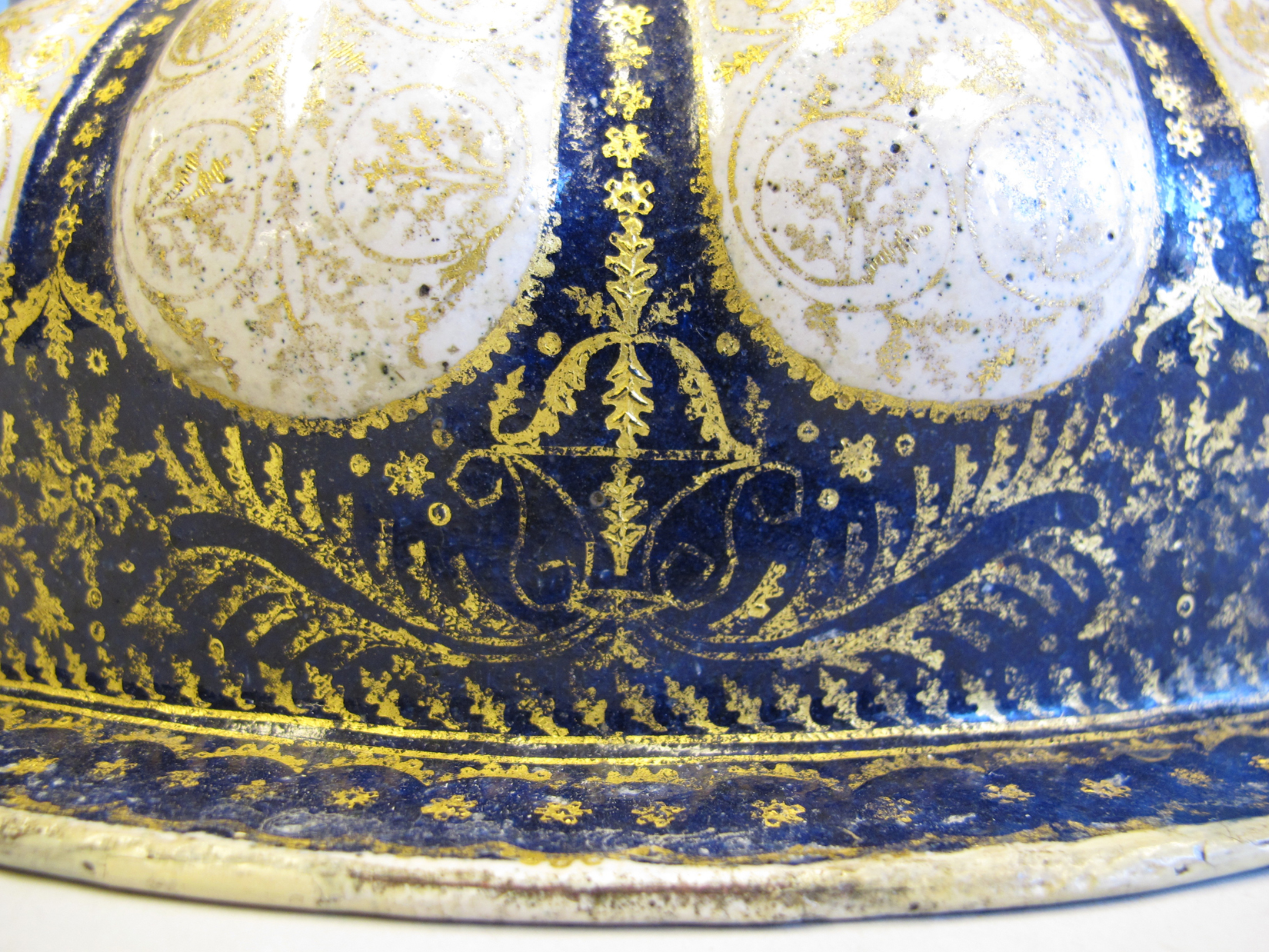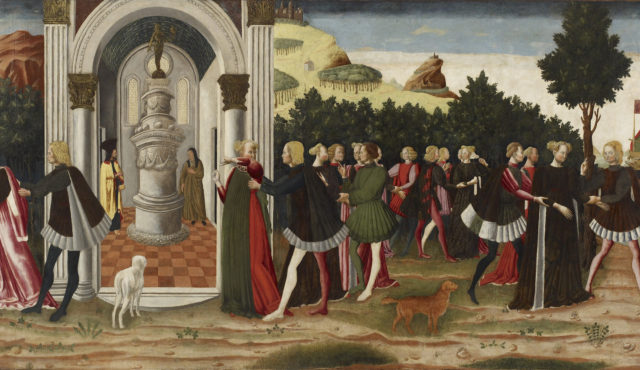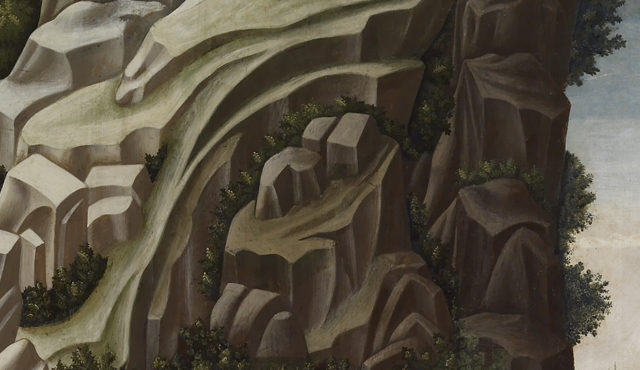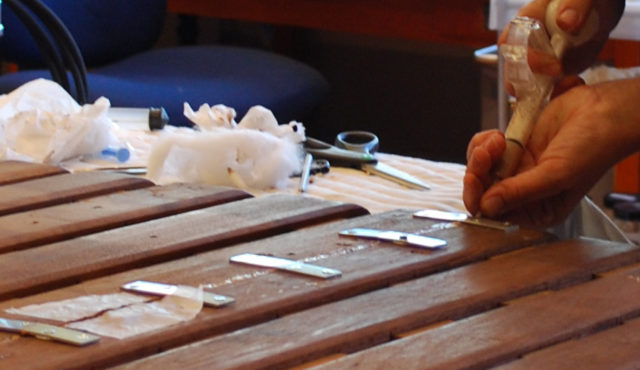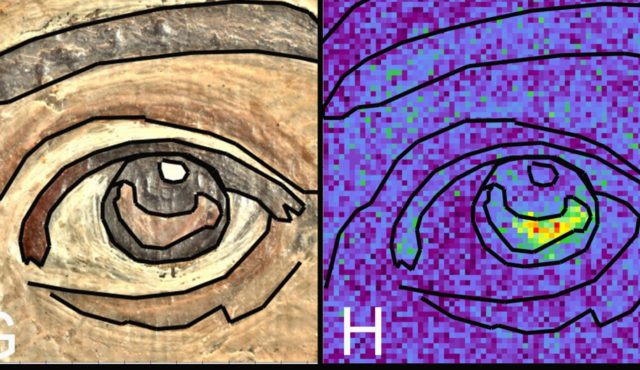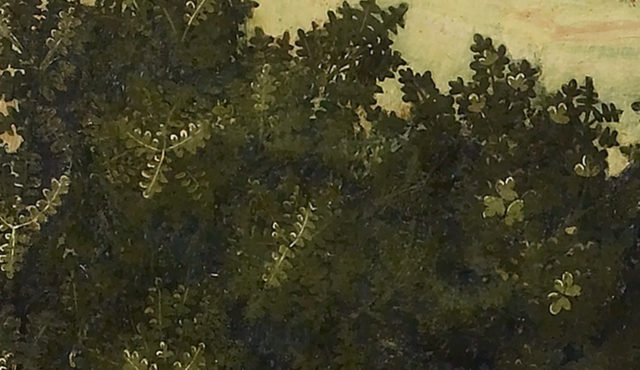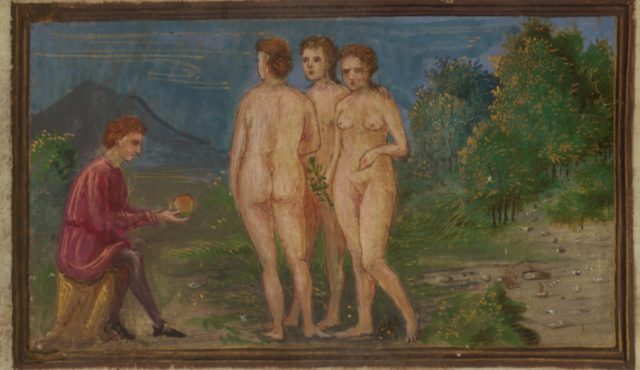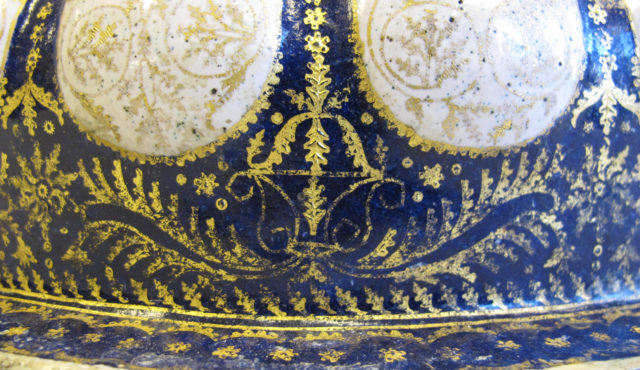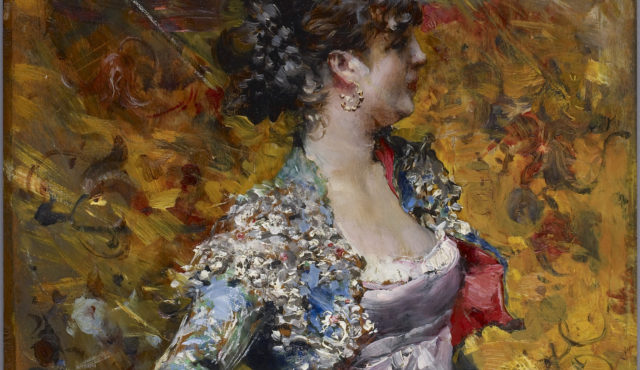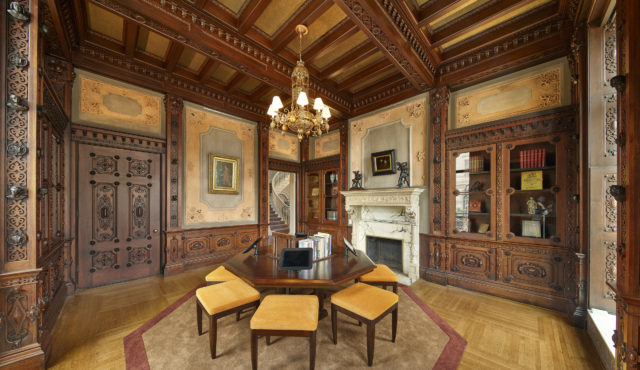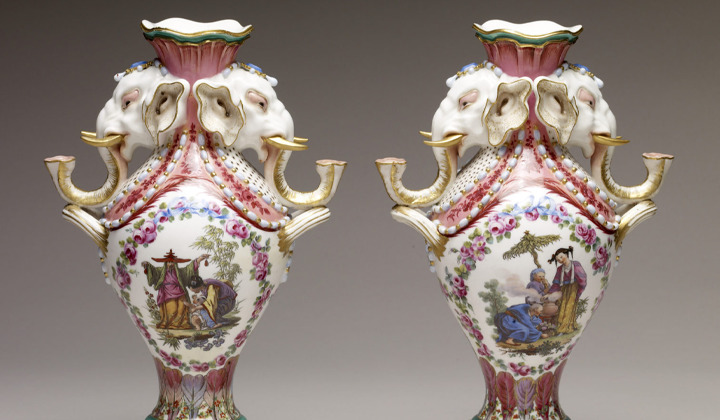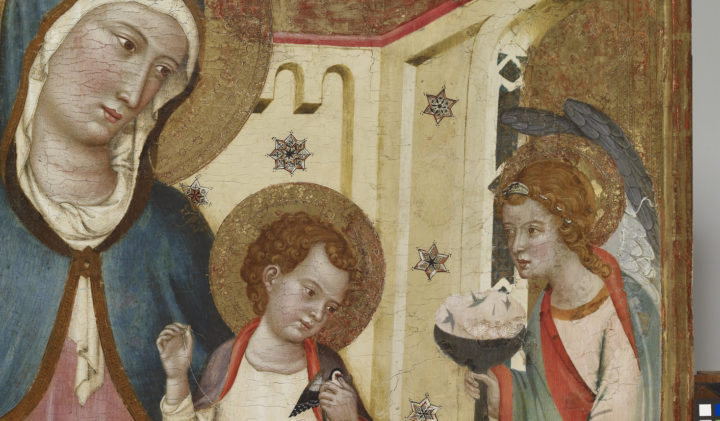In 2014, a large enameled footed bowl (fig. 1) was transferred to the Walters Art Museum’s Department of Conservation and Technical Research for repair because it was structurally unstable. The object is composed of three main decorative parts: a large bowl at top, a footed base, and in between, an ornamental knob, or knop. The internal structure that anchored these parts together was damaged, causing the heavy bowl and knop to rock against the top of the foot, where a thin gilded copper mount was crushing original material. Prior to treatment, careful examination from conservation, curatorial, and scientific perspectives raised several questions, namely: what structural changes had occurred over time, and how might these changes elucidate the life of this object? Was the footed bowl in its original state, or might this object be a pastiche—a composite assembly of parts from different objects?
This impressively large work (fig. 1), standing more than 10 inches tall and 12 inches wide at its maximum diameter (27 × 32 cm), would have been used by a wealthy host to amaze guests, perhaps filled with sugary confections as a centerpiece during dinner or displayed as an object of luxury when not in use. It is part of a group of four painted enamel-on-copper objects with applied gilding in the Walters’ collection; all are attributed to Venetian manufacture and dated about 1500: the others are a candlestick (fig. 2), a reliquary (fig. 3) and an object described as the body of a goblet vase (fig. 4).[1] These objects were hammered from copper sheets, and then were decorated with enamel by fusing a thin layer of powdered glass to the copper using high heat; finally, patterns of gold foil were applied and fused to the enamel surface using lower, but still elevated, temperatures.
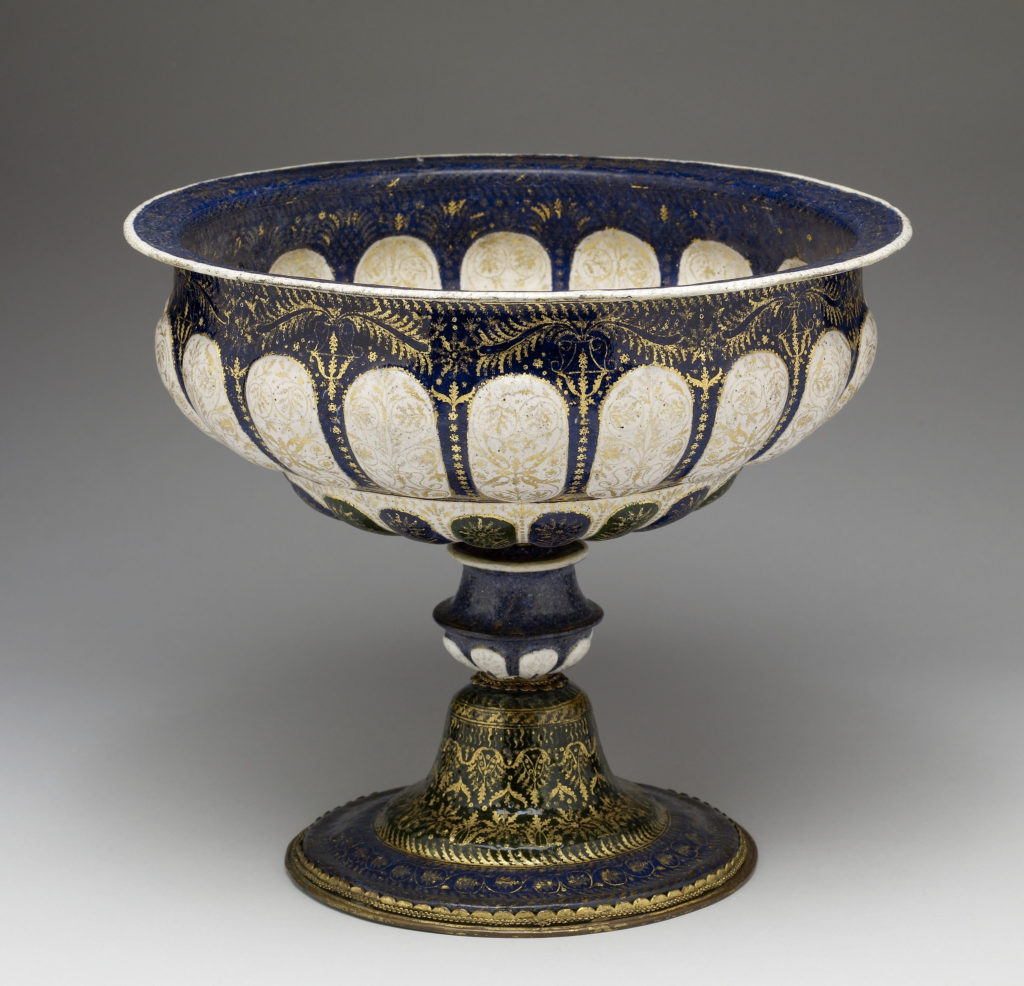
Footed Bowl, Venetian, ca. 1480–1500. Enamel on copper, height 10 5/8 in.; maximum diam. 12 5/8 in. (27 × 32 cm). Bequest of Henry Walters, 1931, acc. no. 44.203
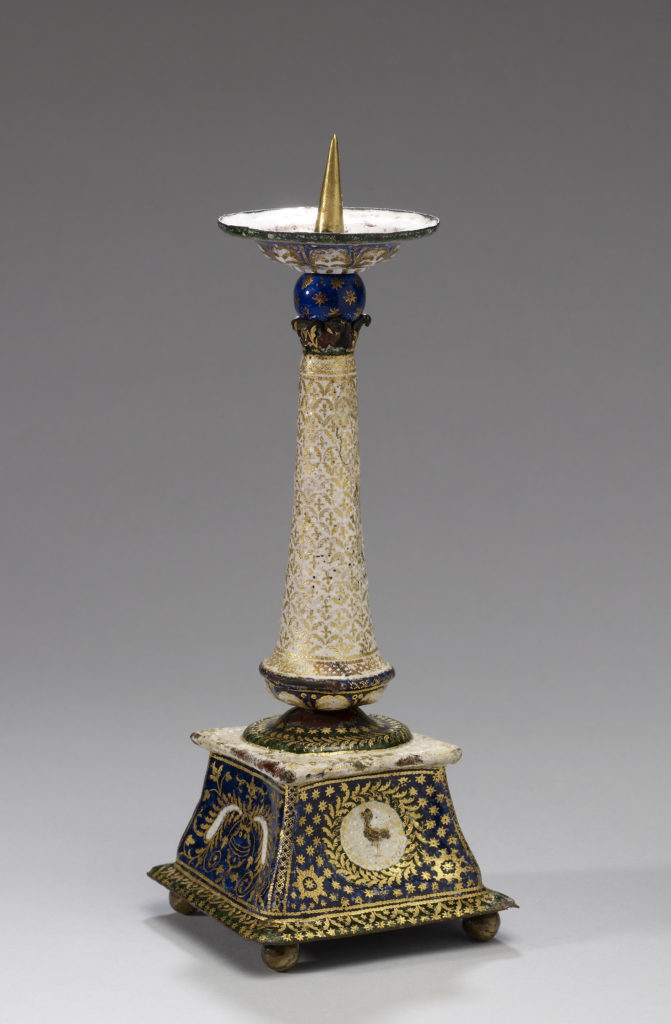
Fig. 2Candlestick with Decorative Motifs, Venetian, ca. 1500. Enamel on copper, height 8 11/16 in. (22 cm). Bequest of Henry Walters, 1931, acc. no. 44.34
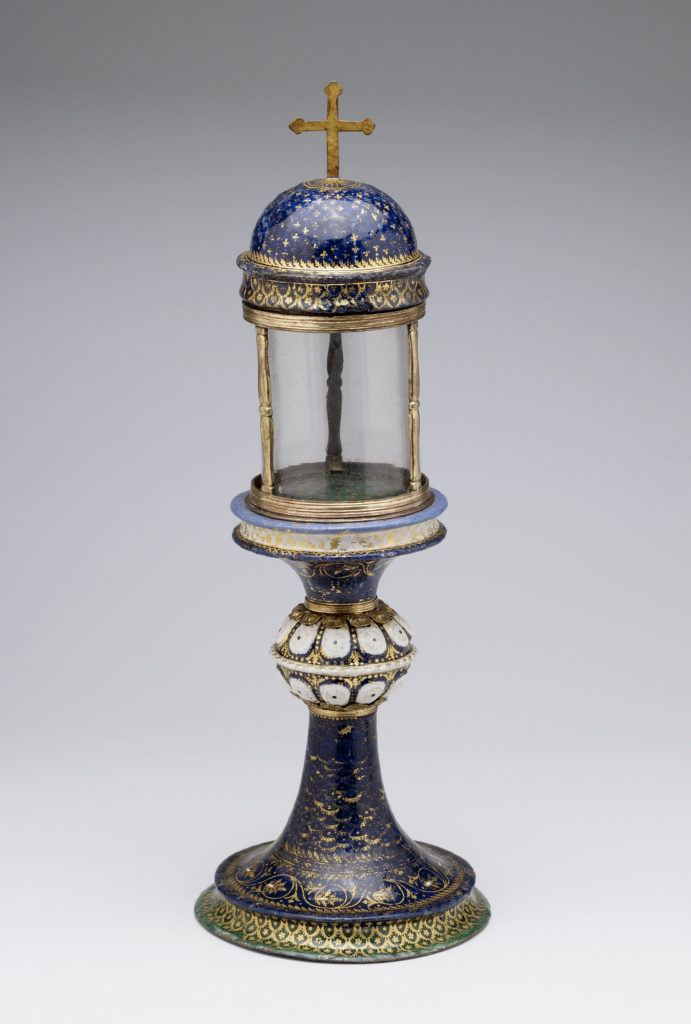
Reliquary with Floral Scrolls, Venetian, ca. 1500. Enamel on copper, height 14 15/16 in.; diam. of base 5 5/16 in. (38 × 13.5 cm). Bequest of Henry Walters, 1931, acc. no. 44.171
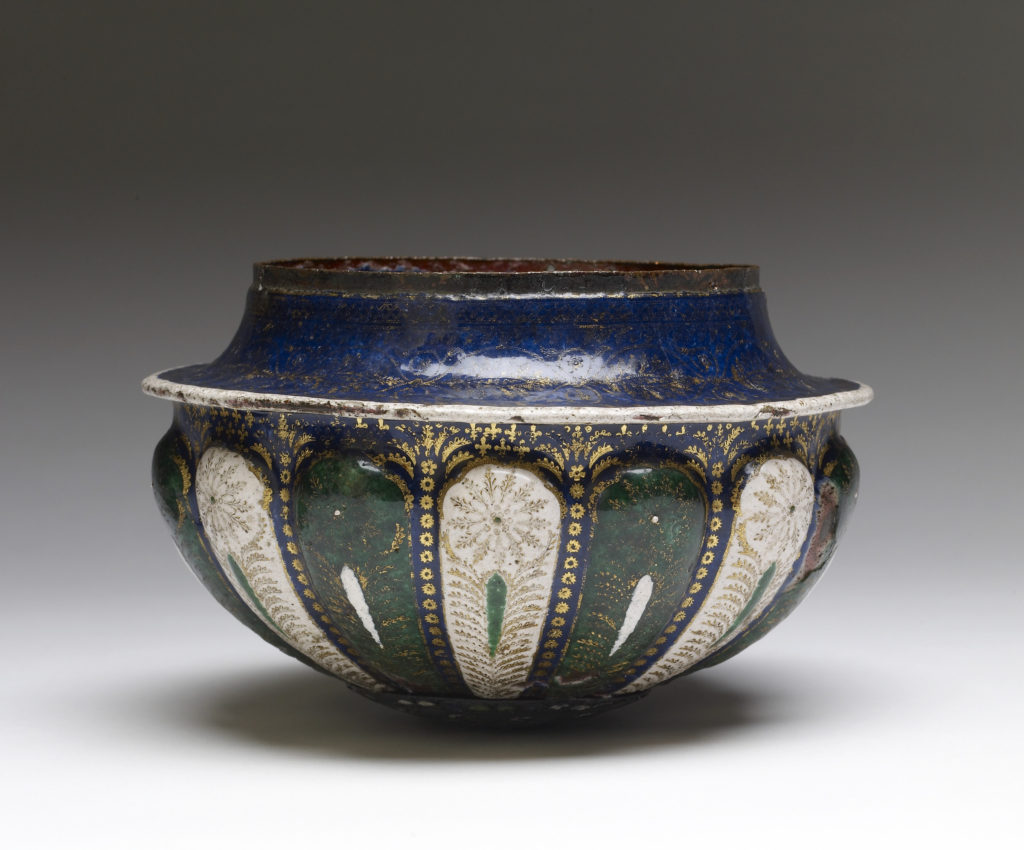
Body of a Goblet Vase, Venetian, ca. 1500. Enamel on copper, height 3 15/16 in.; diam. 5 7/8 in.
(10 × 15 cm). Bequest of Henry Walters, 1931, acc. no. 44.180
The close study and examination of the footed bowl coincides with international interest and investigation surrounding comparable Renaissance enamels.[2] More than 350 similar enamel-on-copper objects are known worldwide.[3] Long thought to have originated in Venice, they have been dated variously from the early fifteenth to the late seventeenth century.[4] The most recent scholarship indicates that the majority of the works were made around 1500.[5] The purported Venetian manufacture of some of these objects has been questioned (Milan and Florence have been proposed as alternatives),[6] but no plausible evidence exists at this time to challenge the Venetian attribution of the four Walters enamels.
To create the footed bowl, the copper bowl, knop, and foot were first covered with a thick layer of opaque white enamel. Translucent blue and translucent green enamels were then applied selectively, accentuating the forms. Finally, eighteen different motifs of textured gold leaf were added (see table 1). These were applied to the surface of the enamel to create repeating patterns and were likely stamped with small tools used to apply fine metallic foil, called paillon, yielding a textured surface. A second layer of translucent blue enamel was applied over some areas of gilding, as on the rounded molding, or gadroons, of the knop. The technique used to create the textured gold is unclear, and the exploration of the technique is a rich area for future research.
Consistent with comparable Venetian Renaissance production, the enamel-on-copper bowl, knop, and foot evidence original attachment and assembly based on mechanical joining, which includes crimping, enameling over split or bent tabs, and cold assembly of multiple components. The complex form of the central knop, for example, was raised from three separate pieces of copper sheet that were crimped and riveted at the joins prior to enameling. Similar mechanical joining techniques were also observed in the construction of the other three enamels in the Walters collection. Such relatively crude mechanical joining contrasts with the more robust techniques of joining and assembly that were commonly employed for enamel-on-copper objects produced around the late fifteenth and sixteenth centuries in Limoges, France.[7] Most Limoges multipart enamels are joined by twisted wires, stitched tabs, or interlocking pins. These methods of joining are much less likely to fail during firing or gentle use, compared with the Walters objects’ mechanical joining techniques of crimped and bent metal.
Two additional enamel-on-copper decorative elements on the Walters footed bowl are not original to the object: a central medallion at the bottom of the bowl (fig. 5) and a circular button inserted into the underside of the foot (figs. 5, 6). These enamels differed in both material and technique from the bowl, knop, and foot; for example, the painted gilding on the medallion has none of the texture that exists on the original gold foil. Indeed, during the course of treatment, documentary evidence was discovered in museum archives suggesting that these alterations might have been introduced by the firm of the Parisian restorer Alfred André in 1906.[8]
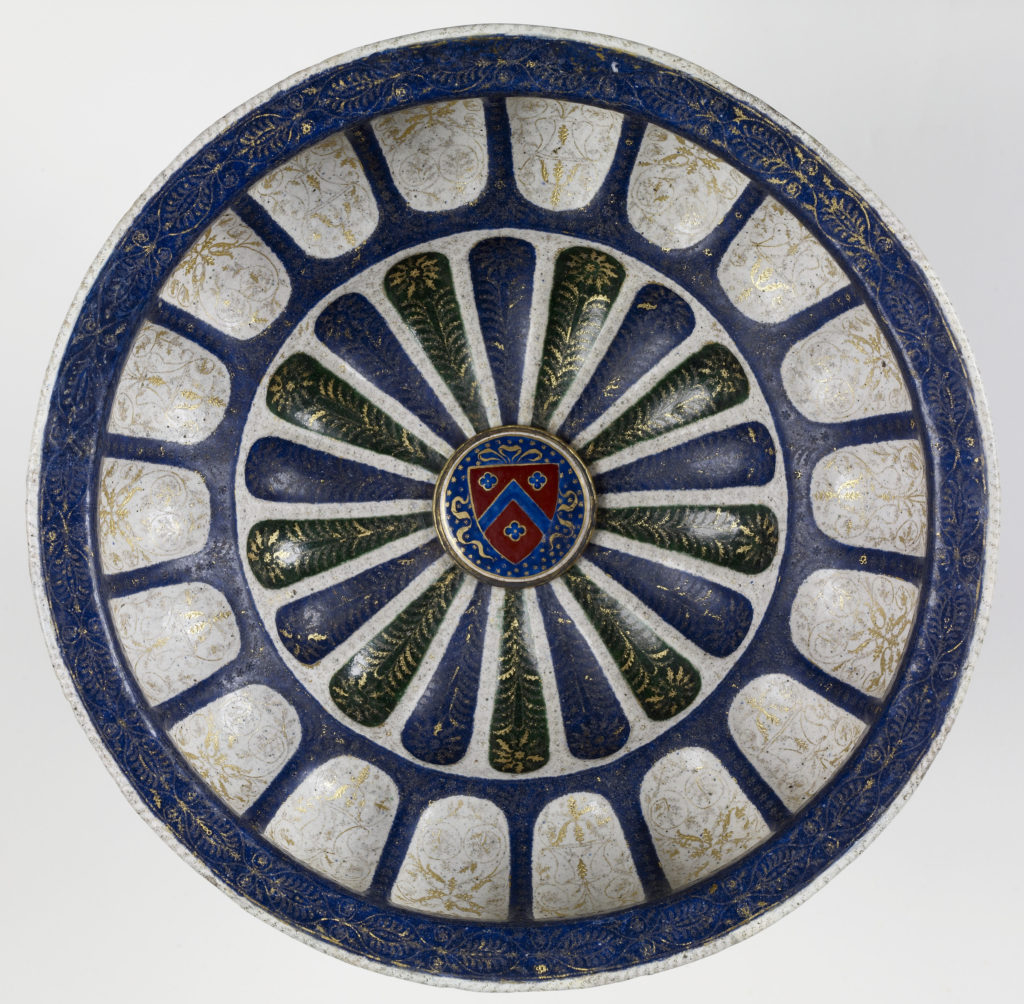
Footed bowl viewed from above, showing the central medallion mounted inside the bowl
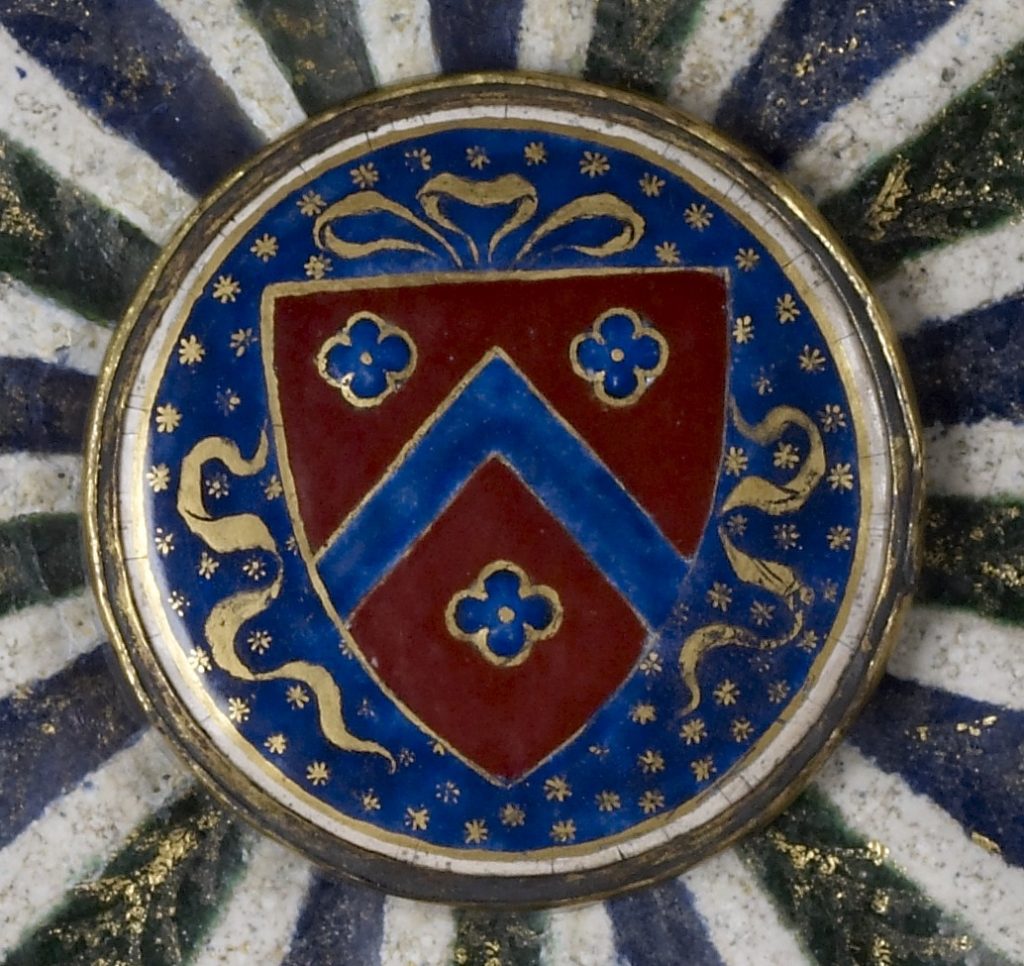
The central medallion mounted inside the bowl above in detail; the medallion’s diameter is approximately 2 inches (5 cm).
X-radiography of the footed bowl, shown in figure 7, also revealed significant evidence of post-1800 restoration of the attachment mechanism (see fig. 8). While the x-ray revealed a connecting tube of rolled copper sheet consistent with the bowl’s Renaissance manufacture,[9] it also revealed a modern, machine-made pipe inside this tube, surrounding a threaded post with a modern nut intended to secure the assembly—all material of the industrial age. This repair was covered by plaster that filled the underside of the foot, and was disguised using a capping enameled-copper circular button. The insertion of this enameled button into the underside of the foot is an anachronism, inconsistent with Venetian Renaissance manufacture. Enameled buttons inserted into the undersides of feet are a feature typical of later enamel on copper objects from Limoges, a construction technique that would have been known to restorers and artists working in historical styles in the nineteenth century.[10]
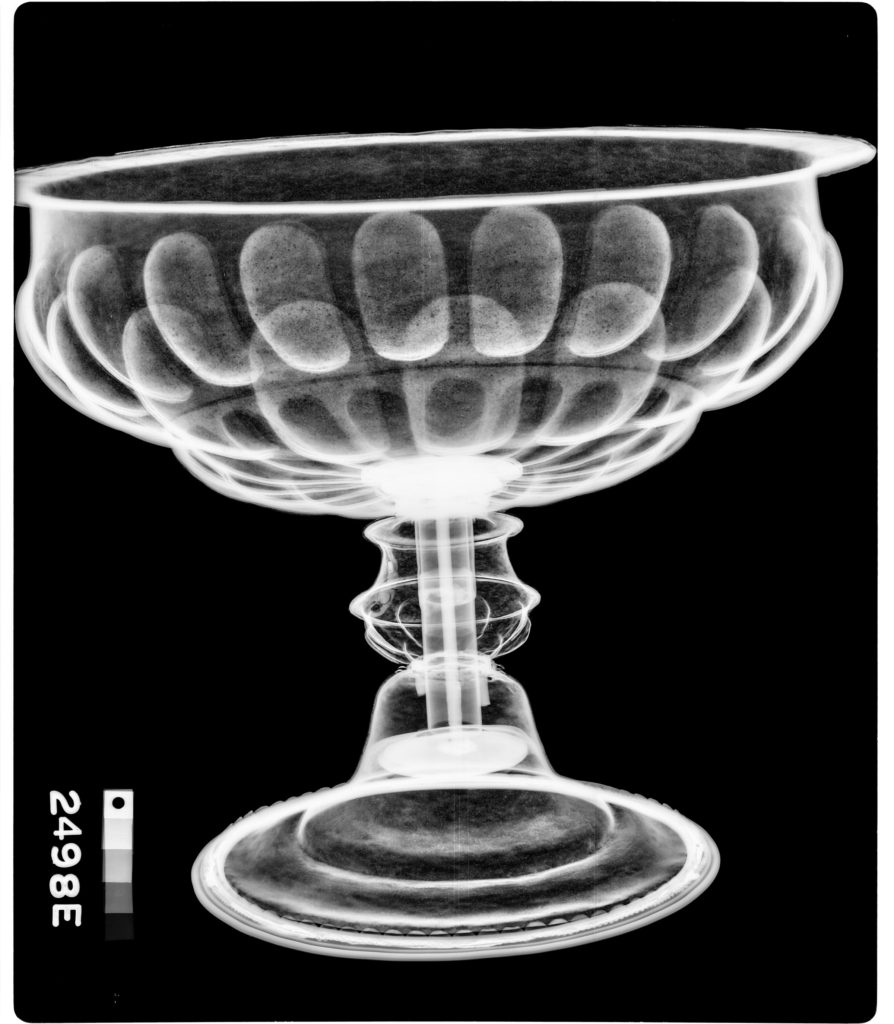
X-radiograph of the footed bowl, revealing the entire assembly

Schematic representation of the footed bowl, with five original elements highlighted in black and probable restorations colored
The coat of arms medallion, with a label on the reverse of the foot inscribed (in English) “arms of the Moncenigo” [sic], seems to have been added after 1800 with the express intent of emphasizing a connection between the Walters footed bowl and Venice. However, the arms are not those of the Mocenigo, one of the great families of Venice, and the label, moreover, misspells the family name.[11] Many objects similar to the Walters footed bowl have coats of arms, some gilded directly onto the enamel and some present as separately applied medallions [12] The presence of the enamel medallion with a purported Venetian coat of arms attests to some familiarity with other objects of this type, but it is also an ingenious and deceptive way to camouflage the non-original, mechanical connection inserted after 1800. The presence of the medallion was undoubtedly intended to create a tangible link to a Venetian past through an invented or reinforced provenance during a restoration campaign, perhaps to enhance the perceived value of the object.
The restorations to the footed bowl were completed with an art-historical understanding of objects of this type as specifically Venetian. The restorations also demonstrate an inability to replicate the textured gilding of the original enamel and some confusion as to original construction techniques, substituting representations of the far more common and familiar construction techniques of Limoges enamel ateliers. The bowl as it is currently assembled thus embodies significant information about the art-historical, material, and technical understanding of so-called Venetian enamel-on-copper objects at the time it was last restored in the early twentieth century.
Comparison of the Walters footed bowl with known examples of Venetian enamel-on-copper objects extant in the early twenty-first century did not reveal any similar objects with a comparable relationship of parts. The unusual appearance and compromised construction suggested that this large object may actually be a pastiche composed of three separate enameled elements: a large bowl, a convex foot, and a knop connecting the two, each from distinct objects.[13] Differences in condition among these three elements further suggested that they might not have always had a shared history and indeed have been assembled at an unknown period. Could the footed bowl be a pastiche of elements produced during the Renaissance or from different periods in imitation of Renaissance production?
To help address these questions, nondestructive x-ray fluorescence spectometry was conducted on the bowl, knop, and foot of the footed bowl. [14] Results from the analyses of the blue enamel identified cobalt as the principal blue colorant. This was expected, since cobalt has been used for centuries to color glassy materials blue. However, the analyses also identified the presence of the metallic element molybdenum (Mo) in the blue enamel used for the bowl, knop, and foot. Why is the identification of molybdenum in the cobalt-based blue enamel significant? First, this was the only instance that molybdenum was identified as a constituent in art at the Walters to-date. The presence of molybdenum was confirmed with additional analytical rigor to prove the indicator of molybdenum was not an artifact of the analytical procedure.[15] Molybdenum has been identified in the blue enamel used on at least two objects in the collection of the Metropolitan Museum of Art during an examination of thirteen Renaissance enameled works of art: a watchcase cover depicting Pomona and Vertumnus and a plate depicting the conversion of Saint Paul, both attributed to Suzanne de Court (French, active 1575–1625).[16]
The particular significance of the detection of molybdenum as it pertains to the Walters footed bowl is that this element is known to occur as a relatively rare impurity in cobalt ores, along with additional impurities such as zinc, lead, arsenic, nickel, indium and bismuth. These impurities may function as specific indicators for time and place of ore extraction, processing and perhaps even utilization. These cobalt-containing ores include the minerals erythrite [(Co, Ni)₃(AsO₄)₂·8H₂O], cobaltite [CoAsS] and skutterudite [CoAs3], which were historically extracted from mountainous sources around present-day Germany, Turkey, and Iran.[17] With the identification of molybdenum in the cobalt-based blue enamel applied to the bowl, the foot, and the knop of the Walters footed bowl there now exists strong material evidence that these three parts were created at similar time and place since all three contain the same, relatively rare, molybdenum impurity.
But when were these enamels actually made? Can cobalt ore impurities help date the production of the enameled metal used for the footed bowl? Indeed, there is significant evidence for cobalt-based blue enamels that specifically date to the period before 1520–1530 as containing relatively high nickel without arsenic and bismuth.[18] The absence of arsenic and bismuth in the footed bowl is likely a consequence of metal processing techniques of the time, since both arsenic and bismuth would be lost during high heat processing of cobalt-containing ores. In contrast, cobalt-based blue enamels produced after 1520–1530 are thought to have retained the arsenic and bismuth found in the mineral ore, a likely consequence of improved, more efficient processing techniques of the time.
The combination of art-historical,
analytical, and material evidence suggests that the Walters footed bowl
originally existed as three closely related objects, probably made in the same
workshop prior to 1520–1530. At some
point the objects were damaged or disassembled; their later reassembly into a
single composite object suggests that they remained together in the same
collection. Thus the Walters footed
bowl, in its current configuration, may be understood as a pastiche created
from fragments of three separate but authentic Venetian enamel on copper
objects dating to the Renaissance. It was restored in the early twentieth
century with additional components specifically added to enhance its Venetian
provenance.
Table 1. Gilded motifs on the Walters Venetian Footed Bowl
| Description | Dimensions (mm) | Location | |
 | 6-petaled flower with raised center and raised center in petals | Diam. 4 | Bowl interior and exterior, interior and exterior rim of bowl, foot, knop |
 | 12-pointed star with raised center | Diam. 2.5 | Bowl interior, knop (?), foot |
 | Large lace with vertically striated pattern and raised dots | 10 × 3 | Bowl interior and exterior, exterior rim of bowl, |
| | Small double-sided oak leaf with raised pattern | 6 × 2.5 | Bowl interior and exterior, interior rim, foot |
 | Set of small curved one-sided oak leaves, left and right, with horizontally striated pattern | 8 × 2 | Bowl outside and inside, rim inside, foot |
 | Large double-sided oak leaf with raised pattern | 8 × 4 | Bowl interior and exterior, foot |
 | Set of one-sided serpentine leaves, left and right, with raised pattern (patterns used in two different directions, resulting in left-sided and right-sided leaves) | 12 × 3 | Bowl interior and exterior, foot |
 | Roundel with raised center | Diam. 2 | Bowl interior and exterior, foot |
 | Small lace with vertically striated pattern | 4.5 × 3.5 × 1.5 | Bowl interior and exterior |
| | Line, some parts with vertically striated patterns | Width 1 | Bowl interior and exterior, rim of bowl interior and exterior, foot |
 | Set double-sided vine leaves, left and right, with impressed pattern | 4.5 × 2.5 | Bowl interior and exterior, foot |
| | Fleur de lis with impressed striated pattern | 4 × 3.5 | Bowl inside and outside |
 | Small double-sided serpentine leaf | 7 × 3.5 | Bowl interior and exterior, foot |
| | Large wavy ray | 8 × 1.5 | Foot |
 | Tripartite fan | 4.5 × 3 | Bowl exterior |
| | Small dotted ray | 5 × 2 | Interior rim of bowl |
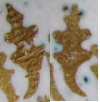 | Set of curved double-sided oak leaves, left and right, with horizontally striated pattern | 6 × 2.5 | Bowl interior and exterior, rim of bowl interior, side of rim of bowl (?), knop, foot |
 | Set of small curved double-sided “acanthus” leaves (heavily damaged), left and right, with horizontally striated pattern | 4 × 2 | Interior rim of bowl inside |
Glenn Gates ([email protected]) is the Conservation Scientist at the Walters Art Museum, Baltimore; Gregory Bailey ([email protected]) is an Objects Conservator at the Lunder Conservation Center, Smithsonian American Art Museum and Renwick Gallery; Eva Helfenstein ([email protected]) is an independent scholar and art historian in Luzern, Switzerland.
The authors are indebted to contributions from Joaneath Spicer, James A. Murnaghan Curator of Renaissance and Baroque Art at the Walters Art Museum, and the reviewers of this note.
[1] See Philippe Verdier, Catalogue of the Painted Enamels of the Renaissance (Baltimore, 1967), 8 (no. 6). This fragment has an inverted rim, whereas all other known goblet vases have everted rims. It conforms to a type of hanging lamp that is rare among the known corpus but survives in at least one intact example.
[2] Françoise Barbe, Isabelle Biron, and Letizia Caselli, eds., I rami smaltati del Rinascimento italiano: Geografia artistica, collezionismo, tecnologia (Les cuivres émaillés dits vénitiens de la Renaissance italienne), Proceedings of the Conference Held in Venice, Italy, October 16–18, 2014. Fondazione Giorgio Cini, Venice, 2 vols. (Milan, 2018). Dr. Helfenstein, as the museum’s Postdoctoral Mellon Fellow in Renaissance and Baroque Art, was the Walters Art Museum’s representative at the conference.
[3] Marco Verita, Isabelle Biron, Andrea Cagnini, Simone Porcinai, and Françoise Barbe, “The So-Called Venetian Enamelled Copper Artworks of the Italian Renaissance: The Technology and Provenance of the Enamels—An Analytical Approach,” Archaeometry 60 (2018): 233–54.
[4] The attribution of these enamel-on-copper objects to Venetian manufacture seems to have emerged in the middle of the nineteenth century, when several examples were described in auction catalogues as “Venetian” and loosely dated to the late Renaissance or Baroque period; the earliest such description may be found in the catalogue for the Préaux sale (Paris, January 9–11, 1850), lot 261. The attribution was codified by Louis Courajod in “Quelques sculptures en bronze de Filarete,” Gazette Archéologique 10 (1885): 382–91. For a discussion of the stylistic links to Venetian craftsmen, see Claire Vincent, “Pilgrim Bottle and Cover,” in Catalogue of the Robert Lehman Collection, 15: Decorative Arts, ed. Wolfram Koeppe (New York, 2012), 87–93.
[5] None of the known examples of this type of enamel are dated or are known to have secure provenance beyond the late seventeenth century, but a ciborium formerly in the collection of Baron Gustave de Rothschild is recorded as bearing the date “ANNO MCCCCCII” [1502]. Its present location is unknown, however, and it is impossible to assess the authenticity of the object or the date; see Albert Darcel, “Union central des Beaux-Arts appliqués à l’industrie: Musée rérospectif. Le Moyen Age et la Renaissance. Les émaux,” Gazette des Beaux-Arts 1 (1866): 48–77.
[6] Paolo Venturelli has argued for a production center in Milan on the basis of art-historical and archival research. See his Smalto, oro, e preziosi: Oreficeria e arti sintuarie nel Ducato di Milano tra Visconti e Sforza (Venice, 2003). Jeremy Warren has argued for a Florentine center of production, based on archival research and art historical analysis. See his “‘Venetian Enamels’: The Case for Florence?” in I rami smaltati del Rinascimento italiano, 1: 55–70. Marco Verità, Isabelle Biron, and others have argued for a Tuscan origin of these enamels based on scientific analysis of the enamel composition and comparison with known Tuscan enamels. See Verità et al. “The So-Called Venetian Enamelled Copper Artworks of the Italian Renaissance.”
[7] For a detailed description of metalworking and joining techniques employed on the copper supports of Limoges painted enamel objects, see Susan LaNiece, Stefan Röhrs, Dora Thornton, and Antony Simpson., “Limoges Painted Enamels: Evidence for Specialist Copper-smithing Workshops,” British Museum Technical Research Bulletin 3 (2009): 13–22.
[8] Correspondence dated June 1, 1906, from Jacques Seligmann to Henry Walters includes a description of the object that reads in part: “Big coupe in old Venice enamel with some repairs. I believe it comes from the Gavet collection. This coupe will be given to Mr. André for repair.” Walters Art Museum Archives, vertical file for 1906. Alfred André was a well-known restorer and occasional forger working in Paris during the late nineteenth and early twentieth centuries. Verdier had previously asserted that the medallion was the work of André, though he did not provide substantiating evidence. See Verdier, Catalogue of the Painted Enamels of the Renaissance, 4–8 (no. 3).
[9] This original tube was mechanically secured to the bowl by split tabs and joined to the foot by a catch snugly fitted against the false foot enameled to the underside, consistent with Venetian Renaissance methodology.
[10]Original construction techniques are replicated in nineteenth-century structural repairs and additions to a late sixteenth- or early seventeenth-century Limoges enamel-on-copper tazza by Suzanne de Court in the Robert Lehman Collection of the Metropolitan Museum of Art, 1975.1.1235; see G. Bailey, 2011 unpublished analyses. There is circumstantial evidence to suggest that this object might also have been restored by the firm of Alfred André.
[11] For the arms of the Mocenigo, see an engraved brass dish, ca. 1550, in the collection of the Victoria and Albert Museum, London.
[12] For example, on the underside of the reliquary with floral scrolls (44.171).
[13] Comparison of this object with other Venetian enamel objects suggests that the bowl likely originally stood on a gadrooned foot of the type observed on an intact example in the collection of the Fondação Abel e João de Lacerda, Caramulo, Portugal (inv. no. FAL 405), whereas the knop might have been part of a candlestick like the pair preserved at the Galleria di Palazzo Cini, Venice (inv. no. FD 40056), and the foot might have been made for a large standing cup like that preserved in the collection of the Palais des Beaux Arts, Paris (inv. no. A.303).
[14] The Artax XRF at 50kV, 560microAmp, for 300 seconds, equipped with a polycapillary Rhodium tube, was used for the analysis executed in air with a helium purge without filters.
[15] Mo was indeed confirmed by the characteristic molybdenum x-ray fluorescence energies at 17.4keV for Kalpha1,2 and at 19.6keV for Kbeta1 manifest as distortion of the rhodium scatter from the target X-ray tube.
[16] G. Bailey, 2011 unpublished analyses, Metropolitan Museum of Art, New York, nos. 1975.1.1240 and 1975.1.1233.
[17] Julian Henderson, Ancient Glass: An Interdisciplinary Exploration (Cambridge and New York, 2013).
[18] Bernard Gratuze, Isabelle Soulier, Maryse Blet, and Lucy Vallauri, “De l’origine du cobalt: Du verre à la ceramique,” Revue d’archéométrie 20 (1996): 77–94; Bernard Gratuze, Isabelle Soulier, Jean-Noel Barrandon, and Daniele Foy, “The Origin of Cobalt Blue Pigments in French Glass from the Thirteenth to Eighteenth Centuries,” in Trade and Discovery: The Scientific Study of Artefacts from Post-Medieval Europe and Beyond, ed.Duncan R. Hook and David Gaimster, British Museum Occasional Paper 109 (London, 1995), 123–33. A. Zucchiatti, A. Bouquillon, I. Katona and A. D’Alessandro, “The ‘Della Robbia Blue’: A Case Study for the Use of Cobalt Pigments in Ceramics during the Italian Renaissance,” Archaeometry 48 (2006): 131–52.
